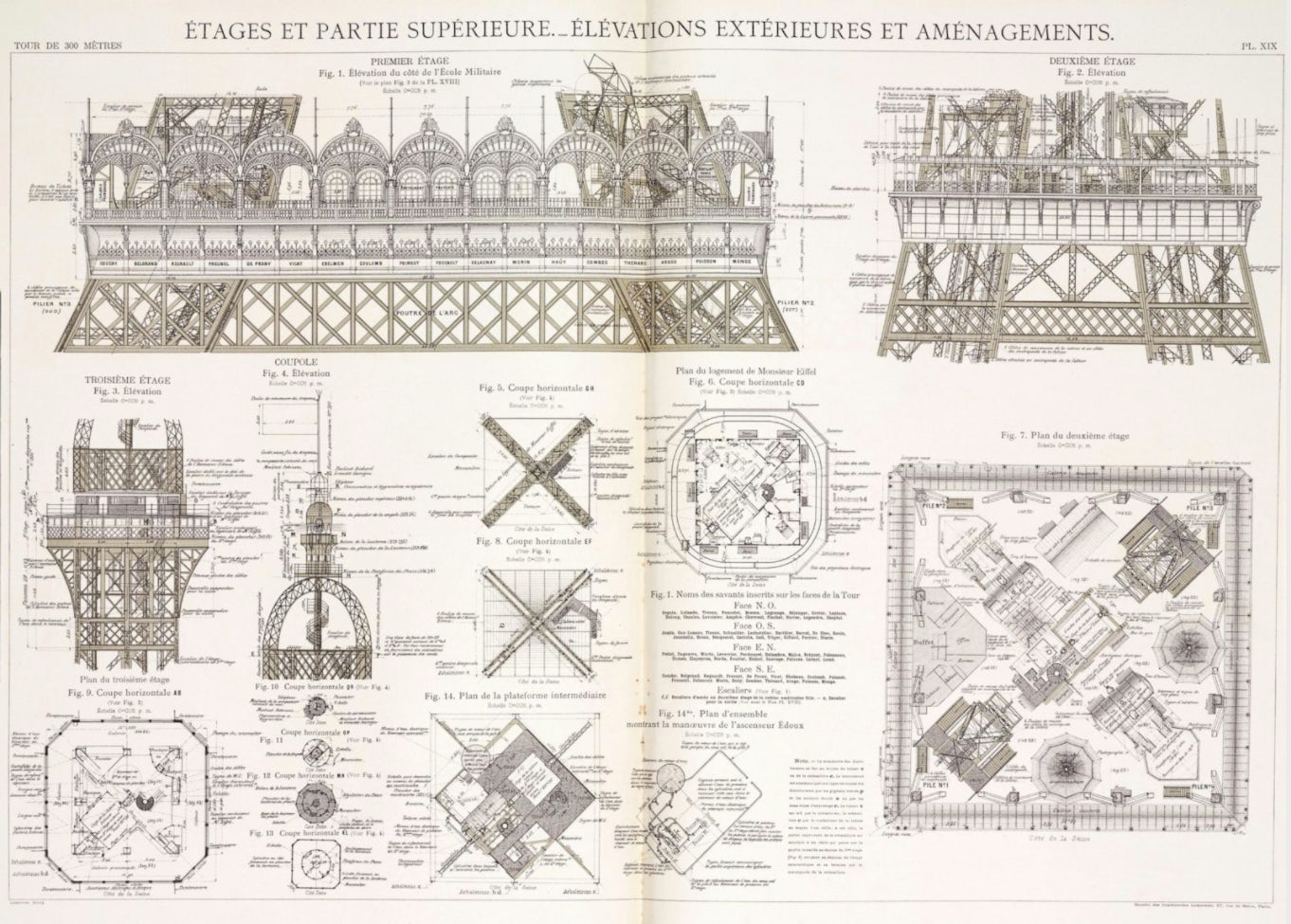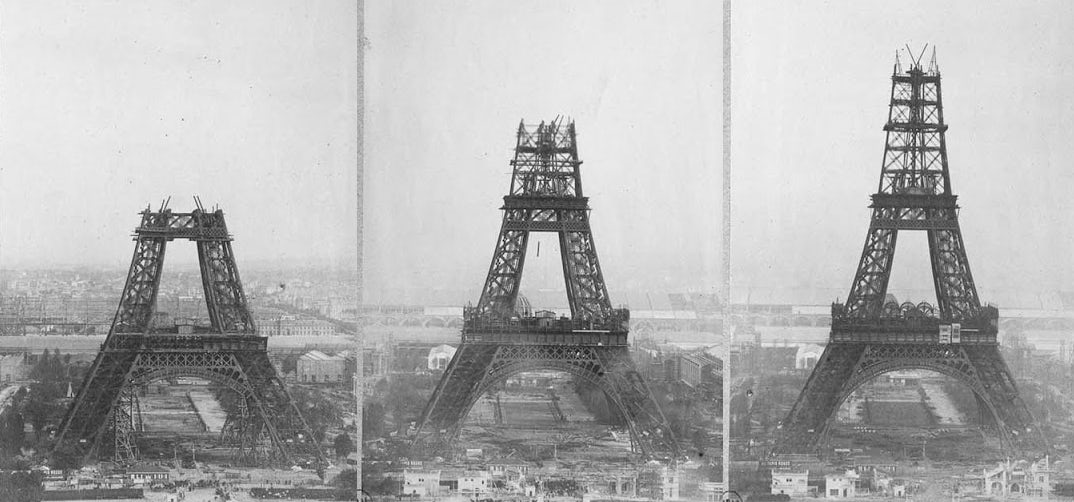Last chance: The 14th Architizer A+Awards celebrates architecture's new era of craft. Apply for publication online and in print by submitting your projects before the Final Entry Deadline on January 30th!
Since it was announced in 2017, the Eiffel Tower in Paris has undergone a €300 million, 15-year renovation, with the aim of preserving this iconic landmark long into the future. This is an extraordinary turn of events when you consider that, upon completion in 1889, the monument was intended to stand for just 20 years, and not only that — its very existence was under threat from the moment it was conceived.
The original proposal of a grand tower to form the centerpiece of the 1889 Exposition Universelle was drafted by two engineers, Maurice Koechlin and Émile Nouguier, and architect Stephen Sauvestre, all while working at Gustave Eiffel’s company. Inspired by the Latting Observatory in New York City, Eiffel said the tower would symbolize “not only the art of the modern engineer, but also the century of industry and science in which we are living.”
The 300-meter (980-foot) tower won unanimous approval from the organizers of the exhibition, but its extraordinary scale and unapologetically industrial language did not please all.

Exposition poster; image via BDZoom.com

Plans for the Eiffel Tower are seen in this undated file photo; image via Science & Society Picture Library/Getty Images
Published by Le Temps in February 1887, a petition of protestation was signed by 300 creatives — one for each meter of the tower’s total height — objecting to its construction on artistic grounds. The petition constituted a fierce revolt against Eiffel’s ambitious proposals, including some seriously visceral metaphors and a passionate plea to think again:
“We, writers, painters, sculptors, architects and passionate devotees of the hitherto untouched beauty of Paris, protest with all our strength, with all our indignation in the name of slighted French taste, against the erection … of this useless and monstrous Eiffel Tower … To bring our arguments home, imagine for a moment a giddy, ridiculous tower dominating Paris like a gigantic black smokestack, crushing under its barbaric bulk Notre Dame … the Louvre … the Arc de Triomphe; all of our humiliated monuments will disappear in this ghastly dream. And for 20 years … we shall see stretching like a blot of ink the hateful shadow of the hateful column of bolted sheet metal.”
To counter protests against its artistic merit, Eiffel doubled down on the symbolic purpose of the wrought-iron monument as a celebration of engineering, science and mathematics. The engineer made this “invocation of science” explicit, honoring those that had helped bring the structure to fruition with the addition of 72 names engraved around the outside of the tower.

One of the steel struts of the Eiffel Tower at the start of its construction in Paris, July 18, 1887; photo by FPG/Hulton Archive/Getty Images; via vintage everyday

A large wood scaffold supported construction of the tower’s first level; image via Keystone-france/Gamma-Keystone/Getty Images.
Despite continued resistance, construction began as planned on Jan. 28, 1887. Huge slabs of concrete and blocks of limestone were installed at the foundation to support the shoe for the ironwork, which began to be assembled in June that year.
At first, the legs of the tower were constructed as cantilevers, but halfway through construction of the first tier, a large timber scaffold was erected for additional support. Critics watching on were quick to jump on this turn of events, question the structural integrity of the tower: Sensational headlines such as “Eiffel Suicide!” and “Gustave Eiffel Has Gone Mad: He Has Been Confined in an Asylum” appeared in local newspapers. Nonetheless, construction continued and the tower’s incredible stability remains on display over 100 years later.

Construction progress on the tower; images via Un Jour de plus à Paris

Illustration of the tower’s first visitors at the summit, 1889; image via BDZoom.com
Even when the tower was completed and opened in March 1889, opinion remained polarized. French writer Guy de Maupassant famously ate lunch in the tower’s restaurant every day because it was the one place in Paris where the tower was not visible. However, while creative professionals remained skeptical, the tower was a huge success with the public: By the end of the exhibition, the tower had seen almost two million visitors, each of whom gained a newfound appreciation for innovative French engineering and an unprecedented view of Paris in the process.
The structure was due to be dismantled in 1909, but when the time came, its functionality as a communications tower had become so crucial that the City of Paris elected to retain it. At the same time, the tide of popular opinion over Eiffel’s design had begun to turn. In 1918, as World War I was reaching its end, writer Guillaume Apollinaire penned a nationalist poem in the shape of the tower to express his feelings about the conflict with Germany. This encapsulates emotions across Paris in relation to the tower — what was once viewed as an incongruous, alien structure was now a key part of the city’s identity, symbolizing the strength of the French in the face of such an extreme national crisis.

Via Wikipedia (NonOmnisMoriar)
To this day, the tower constitutes one of the most powerful examples of architecture as a metaphor for national pride, and has become the quintessential “icon” against which all contemporary urban landmarks are measured. Once the planned renovations are complete, it could stand for another century — not bad going for a building that was poised for demolition 108 years ago.
If there is one thing architects can take away from studying the curious story of the Eiffel Tower, it is this: If your building is hated by the public upon its completion, don’t lose hope.
Just give it a little time.
Last chance: The 14th Architizer A+Awards celebrates architecture's new era of craft. Apply for publication online and in print by submitting your projects before the Final Entry Deadline on January 30th!
Top image: construction progress on the tower; images via Un Jour de plus à Paris




